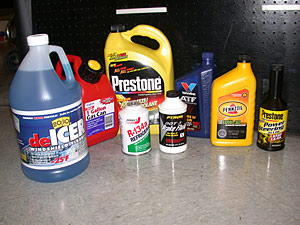Flammability Characteristics of Vehicle Fluids
Detailed Definitions
Flammability Characteristics of Vehicle Fluids
Detailed Definitions
 Definitions from the previous page are repeated here with additional technical details as to how they are measured.
Definitions from the previous page are repeated here with additional technical details as to how they are measured.
|
Flash point
The flash point of a liquid is the lowest temperature of a liquid, as determined by specific laboratory tests, at which the liquid gives off vapor at a sufficient rate to support a momentary flame across its surface [1]. ASTM (formerly American Society for Testing and Materials) publishes open and closed cup test procedures [2-4, 6] for repeatable flashpoint measurements; the value will vary considerably with conditions. Most Material Safety Data Sheets (MSDS) for vehicle liquids list flash point.
Autoignition
The term “autoignition” is used differently in different sources and contexts. NFPA 921 [1] includes the following definitions:
Autoignition: Initiation of combustion by heat but without spark or flame.
Autoignition temperature: The lowest temperature at which combustion material ignites in air without a spark of flame.
Autoignition temperature, a material property, varies substantially with conditions; the term “minimum autoignition temperature” is sometimes presumed to refer to the temperature measured for a given material using an ASTM specified procedure [5].
For more information about the variation in the minimum autoignition temperature measured using small variations in conditions,
click here.
Fire point
Fire point is the lowest temperature at which a material can produce vapors fast enough to support continuous combustion [4, 6-7]. Flashpoint does not require combustion to be sustained; fire point is generally somewhat higher than flash point.
Flammability limits
Flammability requires a fuel and oxygen together. Flammability limits are the boundaries of high and low fuel concentration, within which flammability is possible.
According to NFPA 921 [1], it is the upper and lower concentration limit at a specified temperature and pressure of a flammable gas or vapor of an ignitable liquid and air, expressed as a percentage of fuel by volume that can be ignited.
Investigators rarely have enough information to know the flammability limits of fires being investigated, but the concept is still inherently important. Because vapors have both upper and lower flammability limits, the conditions in which fire is possible are constrained. For example, the concentration of gasoline vapor in a closed gasoline tank is above the flammability limit (too rich) and therefore will not ignite.
Combustible and flammable liquids
There are two additional terms that are sometimes encountered in fire investigation:
Combustible liquid: A liquid having a flash point at or above 37.8 degrees C (100 degrees F). [1]
Flammable liquid: A liquid that has a closed-cup flash point that is below 37.8 degrees C (100 degrees F) and a maximum vapor pressure of 2068 mm Hg (40 psia) at 37.8 degrees C. [1].
To view references for this page before continuing click here,